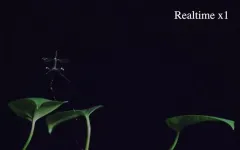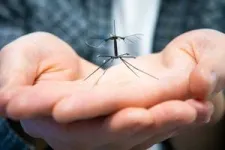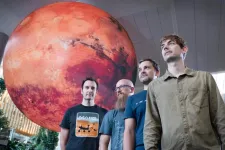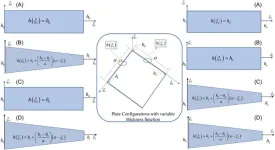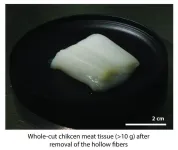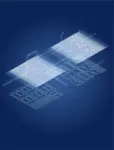(Press-News.org) The Harvard RoboBee has long shown it can fly, dive, and hover like a real insect. But what good is the miracle of flight without a safe way to land?
A storied engineering achievement by the Harvard Microrobotics Laboratory, the RoboBee is now outfitted with its most reliable landing gear to date, inspired by one of nature’s most graceful landers: the crane fly.
Publishing in Science Robotics, the team led by Robert Wood, the Harry Lewis and Marlyn McGrath Professor of Engineering and Applied Sciences in the John A. Paulson School of Engineering and Applied Sciences (SEAS), has given their flying robot a set of long, jointed legs that help ease its transition from air to ground. The robot has also received an updated controller that helps it decelerate on approach, resulting in a gentle plop-down.
These improvements protect the robot’s delicate piezoelectric actuators – energy-dense “muscles” deployed for flight that are easily fractured by external forces from rough landings and collisions.
Landing has been problematic for the RoboBee due in part to how small and light it is – weighing just a tenth of a gram, with a wingspan of 3 centimeters. Previous iterations suffered from significant ground effect, or instability as a result of air vortices from its flapping wings – much like the groundward-facing full-force gales generated by helicopter propellers.
“Previously, if we were to go in for a landing, we’d turn off the vehicle a little bit above the ground and just drop it, and pray that it will land upright and safely,” explained co-first author Christian Chan, a graduate student who led the mechanical redesign of the robot.
Their paper describes improvement of the robot’s controller, or brain, to adapt to the ground effects as it approaches, an effort led by co-first author and former postdoctoral researcher Nak-seung Patrick Hyun. Hyun led controlled landing tests on a leaf as well as rigid surfaces.
“The successful landing of any flying vehicle relies on minimizing the velocity as it approaches the surface before impact and dissipating energy quickly after the impact,” said Hyun, now an assistant professor at Purdue University. “Even with the tiny wing flaps of RoboBee, the ground effect is non-negligible when flying close to the surface, and things can get worse after the impact as it bounces and tumbles.”
The lab looked to nature to inspire mechanical upgrades for skillful flight and graceful landing on a variety of terrains. They chose the crane fly, the relatively slow-moving, harmless insect that emerges from spring to fall and is often mistaken for a giant mosquito. “The size and scale of our platform’s wingspan and body size was fairly similar to crane flies,” Chan said.
They noted crane flies’ long, jointed appendages that most likely give the insects the ability to dampen their landings. Crane flies are further characterized by their short-duration flights – much of their brief adult lifespan (days to a couple weeks) is spent landing and taking off.
Considering specimen records from Harvard's Museum of Comparative Zoology database, the team created prototypes of different leg architectures, settling on designs similar to a crane fly’s leg segmentation and joint location. The lab used manufacturing methods pioneered in the Harvard Microrobotics Lab for adapting the stiffness and damping of each joint.
Postdoctoral researcher and co-author Alyssa Hernandez brought her biology expertise to the project, having received her Ph.D. from Harvard’s Department of Organismic and Evolutionary Biology, where she studied insect locomotion. “RoboBee is an excellent platform to explore the interface of biology and robotics,” Hernandez said. “Seeking bioinspiration within the amazing diversity of insects offers us countless avenues to continue improving the robot. Reciprocally, we can use these robotic platforms as tools for biological research, producing studies that test biomechanical hypotheses.”
Currently the RoboBee stays tethered to off-board control systems. The team will continue to focus on scaling up the vehicle and incorporating onboard electronics to give the robot sensor, power, and control autonomy – a three-pronged holy grail that would allow the RoboBee platform to truly take off.
“The longer-term goal is full autonomy, but in the interim we have been working through challenges for electrical and mechanical components using tethered devices,” said Wood. “The safety tethers were, unsurprisingly, getting in the way of our experiments, and so safe landing is one critical step to remove those tethers.”
The RoboBee’s diminutive size and insect-like flight prowess offer intriguing possibilities for future applications, including environmental monitoring and disaster surveillance. Among Chan’s favorite potential applications is artificial pollination – picture swarms of RoboBees buzzing around vertical farms and gardens of the future.
The National Science Foundation Graduate Research Fellowship Program under Grant No. DGE 2140743 supported this research.
Learn more: https://youtu.be/IIuBagiw17U
END
RoboBee comes in for a landing
Microrobot gets crane fly-inspired legs for soft touchdowns
2025-04-16
ELSE PRESS RELEASES FROM THIS DATE:
“Ban-the-Box” policy did not effectively help job applicants with criminal records in one analysis
2025-04-16
Analysis of job applicant data from one large employer suggests that a policy meant to improve employment prospects for people with criminal records did not actually lead to changes in job offers for people with records. Deborah Weiss of Northwestern University, U.S., and colleagues present these findings in the open-access journal PLOS One on April 16, 2025.
Parts of the U.S. have introduced “Ban-the-Box” (BTB) laws, which aim to improve job prospects for people with criminal records. ...
Sunscreen, clothes and caves may have helped Homo sapiens survive 41,000 years ago
2025-04-16
ANN ARBOR—Ancient Homo sapiens may have benefitted from sunscreen, tailored clothes and the use of caves during the shifting of the magnetic North Pole over Europe about 41,000 years ago, new University of Michigan research shows.
These technologies could have protected Homo sapiens living in Europe from harmful solar radiation. Neanderthals, on the other hand, appear to have lacked these technologies and disappeared around 40,000 years ago, according to the study, published in Science Advances and led by researchers at Michigan Engineering and the U-M Department of Anthropology.
The team found ...
"Big surprise": astronomers find planet in perpendicular orbit around pair of stars
2025-04-16
Astronomers have found a planet that orbits at an angle of 90 degrees around a rare pair of peculiar stars. This is the first time we have strong evidence for one of these ‘polar planets’ orbiting a stellar pair. The surprise discovery was made using the European Southern Observatory’s Very Large Telescope (VLT).
Several planets orbiting two stars at once, like the fictional Star Wars world Tatooine, have been discovered in the past years. These planets typically occupy orbits that roughly align with the plane in which their host stars orbit each ...
Astronomers find rare twist in exoplanet’s twin star orbit
2025-04-16
Astronomers have discovered a planet that orbits at a 90-degree angle around a rare pair of strange stars – a real-life ‘twist’ on the fictional twin suns of Star Wars hero Luke Skywalker’s home planet of Tatooine.
The exoplanet, named 2M1510 (AB) b, orbits a pair of young brown dwarfs — objects bigger than gas-giant planets but too small to be proper stars. Only the second pair of eclipsing brown dwarfs known – this is the first exoplanet found on a right-angled path to the orbit of its two host stars.
An international team of researchers led ...
Crystal clues on Mars point to watery and possibly life-supporting past
2025-04-16
A QUT-led study analysing data from NASA’s Perseverance rover has uncovered compelling evidence of multiple mineral-forming events just beneath the Martian surface – findings that bring scientists one step closer to answering the profound question: did life ever exist on Mars?
The QUT research team led by Dr Michael Jones, from the Central Analytical Research Facility and the School of Chemistry and Physics, includes Associate Professor David Flannery, Associate Professor Christoph Schrank, Brendan Orenstein and Peter Nemere, together with researchers from North America and Europe.
The findings were published in the prestigious journal ...
Microbes in Brooklyn Superfund site teach lessons on fighting industrial pollution
2025-04-16
Using advanced DNA sequence analysis, a research team led by NYU Tandon School of Engineering's Assistant Professor Elizabeth Hénaff has discovered that tiny organisms in Brooklyn's highly contaminated Gowanus Canal have developed a comprehensive collection of pollution-fighting genes.
The findings were published in the Journal of Applied Microbiology on April 15, 2025.
The team identified 455 species of microorganisms wielding 64 different biochemical pathways to degrade pollutants ...
Porous and powerful: How multidirectional grading enhances piezoelectric plate performance
2025-04-16
Piezoelectric materials have long been celebrated for their ability to convert mechanical energy into electrical energy, making them indispensable in smart systems for sensing, actuation, and vibration control. However, incorporating porosity and multidirectional grading into these materials introduces a host of challenges in understanding their behavior under varying environmental conditions. These complexities are further compounded by the interaction of hygrothermal conditions with electrical and mechanical loads. As a result, there is a pressing need for more in-depth research to predict the real-world performance of these materials.
Published ...
Study finds dramatic boost in air quality from electrifying railways
2025-04-16
Switching from diesel to electric trains dramatically improved the air quality aboard the San Francisco Bay Area’s Caltrain commuter rail line, reducing riders’ exposure to the carcinogen black carbon by an average of 89%, finds a new study published today in the journal Environmental Science and Technology Letters.
The electrification of the system also significantly reduced the ambient black carbon concentrations within and around the San Francisco station, the study found.
“The transition from diesel to electric trains occurred over just a few weeks, and yet we saw the same drop in black carbon concentrations in the station as California ...
Bite-sized chunks of chicken with the texture of whole meat can be grown in the lab
2025-04-16
A bioreactor that mimics a circulatory system can deliver nutrients and oxygen to artificial tissue, enabling the production of over 10 grams of chicken muscle for cultured meat applications. These results are publishing in the Cell Press journal Trends in Biotechnology on April 16.
“Our study presents a scalable, top-down strategy for producing whole-cut cultured meat using a perfusable hollow fiber bioreactor,” says senior author Shoji Takeuchi of The University of Tokyo. “This system enables cell distribution, alignment, contractility, ...
A compact, mid-infrared pulse generator
2025-04-16
Physicists in the Harvard John A. Paulson School of Engineering and Applied Sciences (SEAS) have created a compact laser that emits extremely bright, short pulses of light in a useful but difficult-to-achieve wavelength range, packing the performance of larger photonic devices onto a single chip.
Published in Nature, the research is the first demonstration of an on-chip, picosecond, mid-infrared laser pulse generator that requires no external components to operate. The device can make what’s called an optical frequency comb, a spectrum of light consisting of equally spaced frequency lines (like a comb), used today in precision measurements. ...
LAST 30 PRESS RELEASES:
Making lighter work of calculating fluid and heat flow
Normalizing blood sugar can halve heart attack risk
Lowering blood sugar cuts heart attack risk in people with prediabetes
Study links genetic variants to risk of blinding eye disease in premature infants
Non-opioid ‘pain sponge’ therapy halts cartilage degeneration and relieves chronic pain
AI can pick up cultural values by mimicking how kids learn
China’s ecological redlines offer fast track to 30 x 30 global conservation goal
Invisible indoor threats: emerging household contaminants and their growing risks to human health
Adding antibody treatment to chemo boosts outcomes for children with rare cancer
Germline pathogenic variants among women without a history of breast cancer
Tanning beds triple melanoma risk, potentially causing broad DNA damage
Unique bond identified as key to viral infection speed
Indoor tanning makes youthful skin much older on a genetic level
Mouse model sheds new light on the causes and potential solutions to human GI problems linked to muscular dystrophy
The Journal of Nuclear Medicine ahead-of-print tip sheet: December 12, 2025
Smarter tools for peering into the microscopic world
Applications open for funding to conduct research in the Kinsey Institute archives
Global measure underestimates the severity of food insecurity
Child survivors of critical illness are missing out on timely follow up care
Risk-based vs annual breast cancer screening / the WISDOM randomized clinical trial
University of Toronto launches Electric Vehicle Innovation Ontario to accelerate advanced EV technologies and build Canada’s innovation advantage
Early relapse predicts poor outcomes in aggressive blood cancer
American College of Lifestyle Medicine applauds two CMS models aligned with lifestyle medicine practice and reimbursement
Clinical trial finds cannabis use not a barrier to quitting nicotine vaping
Supplemental nutrition assistance program policies and food insecurity
Switching immune cells to “night mode” could limit damage after a heart attack, study suggests
URI-based Global RIghts Project report spotlights continued troubling trends in worldwide inhumane treatment
Neutrophils are less aggressive at night, explaining why nighttime heart attacks cause less damage than daytime events
Menopausal hormone therapy may not pose breast cancer risk for women with BRCA mutations
Mobile health tool may improve quality of life for adolescent and young adult breast cancer survivors
[Press-News.org] RoboBee comes in for a landingMicrorobot gets crane fly-inspired legs for soft touchdowns
